The Everlasting Hoard
The hoard of the Temple treasure that everyone searched for had its origin when Moses directed the fabrication of the Tabernacle furniture and vessels. The first mention of the make up of the hoard is found in the Bible. The Book of Exodus 25-28 sets out the specifications and 37-39 describes the fabrication.
We will pick up history at the conclusion of the Israelites’ forty years in the wilderness, when the mobile Tabernacle with its famous items, the Ark of the Covenant, the Table of Shewbread, the Altar of Sacrifice, the Great Menorah and the accumulated vessels of gold are given a permanent place of abode in what was to become the First Temple of Yuru-salem (Jerusalem).
Previous to this, there is one recording of a looting of sorts found in the first book of Samuel when a tactical error on the part of the Israelites caused the Ark of the Covenant and its immediate accoutrements to fall into the hands of the Philistines who took them to Ashdod. After calamities fell upon Ashdod’s inhabitants the Ark was dispatched first to Gath then to Ekron but after those cities suffered similarly from its presence the now thoroughly blighted Philistines hastily gave the lot back to the Israelites (along with a trespass offering of five golden emerods and five golden mice). Sometime in the late 10th century BC, after a period of conquest and consolidation of his empire by King David, his son Solomon (also called Jedediah) succeeded to the throne and embarked on building the (First) Temple in Jerusalem to permanently house the Tabernacle and its sacred items.
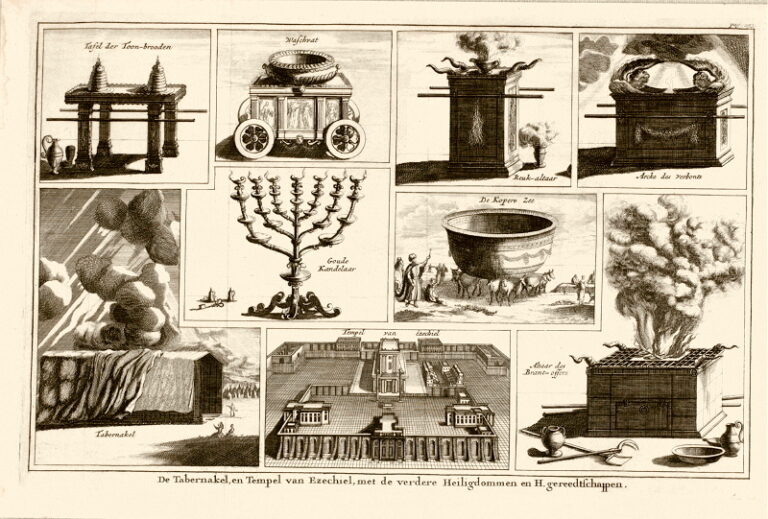
In the early days of the Jewish nation there was so much ‘smiting’ and ‘leading into captivity’ of the Hebrews by neighbouring states that a vicious cycle of looting, destruction and replenishment developed for the Temple. After each looting, the Jewish artisans restocked the Temple with replacement furnishings and equipment. Each time though these replenishments were of such a vast accumulation of wealth that it just enticed the other nations to another round of smiting and leading into captivity. The term ‘Temple treasure’ merely denotes then the collective group of the copied furnishings, fittings and wealth that were made off with at some particular time during the eras of the Temple’s occupancy, there being more than one of these looting events.
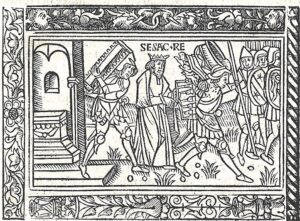
King Herod lastly undertook major capital works to rebuild and completely remodel the (Second) Temple Jerusalem (the first Temple having been razed earlier). The end to this cycle was when the city fortifications were finally breached by Titus’ Legions in 70 AD who slaughtered, pillaged and destroyed on a, for want of a better descriptor, biblical scale. The Temple was never to be rebuilt again.
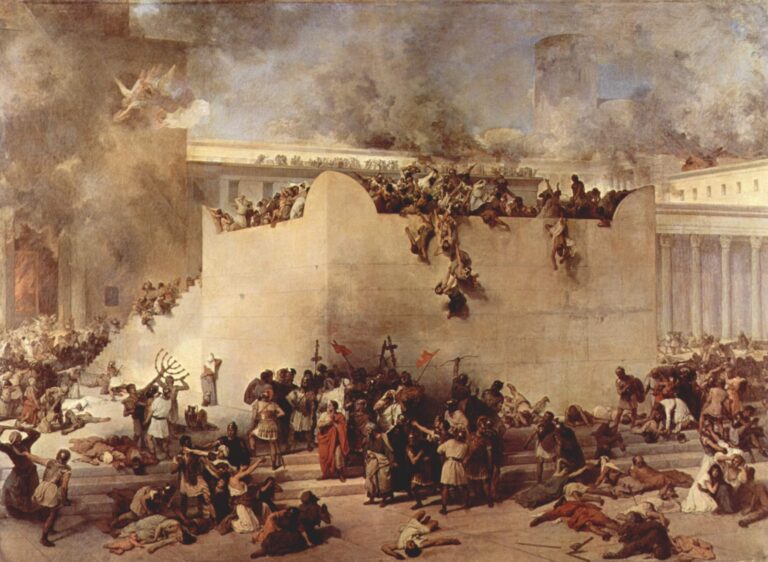
Flavius Josephus, born Joseph ben Mattias, the son of a Hasmonean priest, was around at the time and changed his allegiance to the Romans (hence the Romanized name). He acted as Titus’ translator and mediator. His writings, ‘The Antiquities of the Jews’ and ‘Wars of the Jews’, are particularly interesting as he reported the contents of the Temple.
Josephus observed the result of the siege unfolding in front of him,
“But now it was that one of the priests, the son of Thebutus, whose name was Jesus, upon having security given him, by the oath of Caesar, that he should be preserved, upon condition that he should deliver to him certain of the precious things that had been reposited in the temple, came out of it, and delivered him from the wall of the holy house two candlesticks like those that lay in the holy house, with tables, and cisterns, and vials, all made of solid gold, and very heavy. He delivered to him the veils and garments, with the precious stones, and a great number of other precious vessels that belonged to their sacred worship.”
Josephus went on to describe the ‘pompous’ show of the campaign’s spoils paraded through Rome,
“But for those that were taken from the temple of Jerusalem, they made the greatest figure of them all; that is the golden table, of the weight of many talents; the candlestick also, that was made of gold, though its construction were now changed from that which we made use of; for its middle shaft was fixed upon a basis, and the small branches were produced out of it to a great length having a likeness of a trident in their position, and had every one a socket made of brass for a lamp at the tops of them.”
Some researchers have fixed upon this comment by Josephus in an effort to argue that Titus never actually got hold of the Temple’s treasure and what was being paraded were just props faked up by the Romans for propaganda purposes. To support this argument the depiction of the menorah shown on Titus’ Arch is pointed to as it is shown with an octagonal base decorated with images of creatures. This is said to contravene Jewish law which prohibited graven images in the Temple but descriptions found in various writings contradict this e.g. in the Temple were to be found cherubim or carved pomegranates/vines used as decoration. As lamp stands from these times tended to be on tripods and given the chaos occurring when the items were seized (see Hayez’s painting of the incident), the configuration of the menorah shown on Titus’ Arch is most likely just the result of a Roman repair job. What becomes clear is that what is shown paraded on the Arch of Titus are truly the items from the Temple. What is clear also is that they were merely just the latest set of reproductive copies to have stocked it.
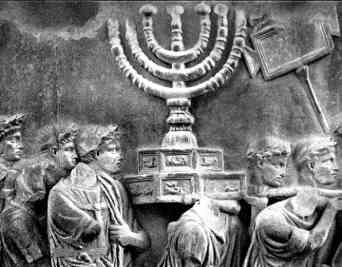
Josephus had also reported of the three ways internecine war raging among the starving inhabitants of Jerusalem even as the Roman siege engines battered the city’s ramparts. Apart from exposing the deep rifts which flowed through Jewish society at the time it provides the insight as to why the secret of the hiding of the original Temple furniture was withheld from these later generations.
A hint to how the original set of furniture was protected from raiders is given in the version of King Josiah’s order which appears as the beginning of the 4th chapter of the tractate Hilchos Beis HaBechirah in the Talmudic writings known as the Rambam;
“There was a stone in the western portion of the Holy of Holies on which the ark was placed. Before it, (were placed) the vial of manna and Aharon’s staff.
When Shlomo constructed the Temple, knowing that it would ultimately be destroyed, he constructed a place for the ark to be entombed below [the Holy of Holies] in deep mazelike vaults.
King Yoshiyahu commanded that the ark be entombed in the chamber which Shlomo had built; as it is written: And he told the Levites who were granted understanding above all of Israel and who were consecrated unto God; “Place the holy ark in the chamber built by Solomon, son of David, King of Israel. You will no (longer) carry it upon your shoulders. Now, go and serve God, your Lord.”
Together with (the ark) were entombed Aharon’s staff, the vial (of manna), and the anointing oil. All of these (sacred articles) did not return in the Second Temple.”
During the construction of the (First) Temple a secret protective vault had been installed and was used as a refuge for some of the most important items of the Temple’s furniture. The order by King Hosiah was for the Levites to leave the Ark permanently in the vault because after this command the Ark no longer appears in any descriptions of the contents of the Temple or amongst any of the looted hoards.
In the writings known as the Mishna, the tractate Shekalim tells an apocryphal story:
“There once was a priest (in the time of the Second Temple) who while working in the Temple noticed that the part of the floor was different from other parts (and realized that at that spot there must be an entrance to a subterranean passage). He told another priest, but barely had he finished speaking before his soul expired, and it was clearly known that that was where the Ark was hidden.”
Josephus even included this telling passage in his writings (the important detail is put in bold), ‘But the innermost part of the temple of all was of twenty cubits. This was also separated from the outer part by a veil. In this there was nothing at all. It was inaccessible and inviolable, and not to be seen by any; and was called the Holy of Holies.’
That the treasure was deliberately hidden to protect it meant that the guardians intended for it to be retrieved at some stage. In case they were no longer around plans would therefore need to be made to cover contingencies such as,
Accident: like a whole cart full of them driving off a cliff,
War: because they were all too familiar with the constant smiting and leading into captivity,
Natural causes: earthquake, plague, famine, drought, sun turning black etc,
Effluxion of time: they may all die out before the Jewish nation was considered by them strong/worthy enough to be given the secret of these sacred items.
These plans would therefore include some type of record of their activities, be it oral or written, so the memory of what they were guarding did not die out with them.
To guard against immediate retrieval of the treasure by an unworthy person obtaining this record, it would be in a form that would not openly disclose the treasure’s location but would still provide enough clues so that someone determined or intelligent enough could later use it (looting Babylonians or Roman soldiers generally not being considered of great intellect).
And Lo, it came to pass that Jewish treasure maps were found.
The Copper Plate of Shimur HaLevi
Retired and improvident mariners in the 19th and 20th centuries use to cadge their rum money at the waterfront by selling to unsuspecting marks what were held out as authentic treasure maps. It is ironic that though they were unaware of it, these maps were actually just mutated and distorted versions of the real map to the Temple treasure. Biblical times likewise had similar articles circulating around. Their version of a treasure map was called a Luach Nehoshet.
One of these articles came to light in March 1952 found in a cave by Henri de Contenson during a search of the Qumran surroundings. This was the same area where the Dead Sea Scrolls were first discovered in 1947. It was a copper plate that had been rolled like a scroll. Due to its age and the effect of oxidation it had broken into two pieces. Due to its fragility it could not be unrolled so a clever solution was developed at the Manchester College of Science and Technology to enable its contents to be read. After coating the external surface with Araldite (a super strong adhesive) a thin saw was used to cut the roll into 23 sections. These were laid out to translate the message that was written in a square form of early Hebrew interspersed with Greek lettering. Here is what it looked like when discovered.
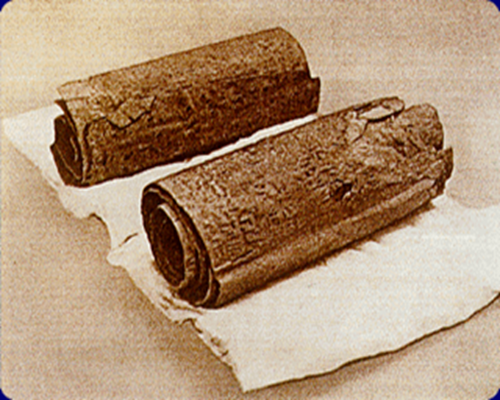
Various translations have been made of its text but the overall message goes something like this;
“In the ruins which are in the Valley of Achor, under the steps which go eastward, forty rod-cubits: a strongbox of silver and its vessels – a weight of seventeen
talents. KEN
In the sepulchre of Ben Rabbah the Third: 100 ingots of gold.
In the big cistern in the court of the peristyle, in a recess of its bottom which is plugged up with sediment, across from the upper opening: nine hundred talents.
In the ruin-heap of Kohlit: vessels of tribute of the master of nations, and ephods. All of this belongs to the tribute and the seventh treasure, a second tithe rendered unclean. Its opening is in the edge of the aqueduct on the north six cubits to the immersion bath. XAG
In the plaster cistern of Manos, on the way down to the left three cubits high from the bottom: forty talents of silver. In the salt pit which is under the steps: 42 talents. HN
In the cave of the old Washer’s Chamber, on the third ledge: sixty-five ingots of gold. ThE
In the vault which is in the court there is donated firewood, in the midst of which, in the recess: vessels and seventy talents of silver.
In the cistern which is across from the Eastern Gate, at a distance of nineteen cubits: in it there are vessels and in the conduit leading into it: ten talents. DI
In the cistern which is under the wall of the east, in the tooth of the cliff: six jars of silver. Its entrance is under the big threshold.
In the pond which is on the east of Kohlit, in the northern corner, dig four… cubits: 22 talents.”
Though the script differs from the other scrolls from Qumran, and is the only one made of copper as opposed to parchment, this copper plate (called the ‘Copper Scroll’) is now part of the collection of Dead Sea Scrolls, its designation being 3Q15 meaning it was from cave 3 at Qumran. Paleographic studies date the plate somewhere between 150 and 70 BC but it also contains earlier Biblical Hebrew from the era 700 BC. The Greek letters interspersed throughout it are thought to be reference marks for scribes but no one is sure. Various mistakes in the subject matter by the person who made the plate have caused scholars to believe it to be the transcription of some folkloric story of the lost treasure of Temple.
Like all good treasure maps what is listed on the copper plate sounds easily locatable, as it seems to give readily identifiable geographic references. It has to, as this is what gives a treasure map its currency, appearing do-able. Persons are even today trying to identify the locations given by the copper plate in and around Jerusalem.
Of course if the locations were easily identifiable or real then any local Israelite in 150 BC, who was much closer to the times, would have just hot-sandled it to the “cistern which is across from the Eastern Gate” to get the treasure rather than just leaving a map to it in a cave.
There is also Latcham’s little joke, the ‘Plancha de Cobre’ (Copper Plate) with its pseudo Hebrew lettering. You can decide that one for yourself.
An inventory of the Temple’s treasure
Some researchers look towards the book of Maccabees that seems to infer that the place to look for the cache of the missing Temple treasure is in a cave on the mountain Moses climbed, taken to be Mt Sinai. What is noticeable is that when the applicable passages are studied they themselves acknowledge they are merely second hand accounts of other writings;
2 Maccabees 2:
1: It is also found in the records, that Jeremy the prophet commanded them that were carried away to take of the fire, as it hath been signified.
4: It was also contained in the same writing, that the prophet, being warned of God, commanded the tabernacle and the ark to go with him, as he went forth into the mountain, where Moses climbed up, and saw the heritage of God.
5: And when Jeremy came thither, he found a hollow cave, wherein he laid the tabernacle, and the ark, and the altar of incense, and so stopped the door.
6: And some of those that followed him came to mark the way, but they could not find it.
These passages posed a question for Rabbi Rachnael Steinberg and his student Rabbi Mendel Tropper; could the records in Maccabees be found? In 1992, they seemed to have done so because in Amsterdam they discovered some long lost writings from 1648 by Rabbi Naftali Hertz Ben Ya’acov Elchanon called the Emeq HaMelekh (Valley of the Kings). In the introduction to the text, Rabbi Hertz included what he called Mishnayots, named so because they were similar in form to the rabbinic written record of oral traditions known as the Misnah. These Mishnayots related directly to the lost Temple treasure.
One of the names proclaiming authorship in the Mishnayots is Shimur HaLevi. This name has been found to also appear on what is known as the Ibex Skin Scroll that was located at Qumran in 1950. In this scroll, Shimur HaLevi gives a detailed account of how to re- institute Temple services.
Likewise in 1952, during renovations in the Beirut Museum, when the writings on two marble tablets, earlier discovered on Mt Carmel were reappraised, they were found to be the same as the Emeq HaMelekh and commenced with,
‘These are the words of Shimur HaLevi, the servant of HaShem. In the year 3331 of Adam.”
To read the words of Shimur HaLevi from the Mishnayot is to truly step back in time. Even through the millennia, they still resonate with dignity and power as they speak of the concealment of what was to become the great lost treasure. It’s also interesting to check this list against the inventories of the treasure given in later stories.
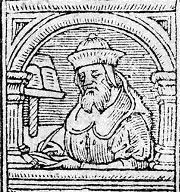
These Mishnayot (Records)
were written by five righteous men.
They are: Shimur the Levite, Hizkiyah, Zidkiyah, Chaggai the Prophet
and Zechariah, son of Ido the Prophet.
They concealed the vessels of the Temple and the wealth of the treasures
that were in Jerusalem which will not be discovered until the day of the coming of Mashiach, son of David,
speedily in our times, Amen, and so it will be.
*
These are the vessels dedicated and concealed
when the Temple was destroyed:
The Tabernacle and the Curtain, the Holy Menorah,
the Ark of Testimony, the golden forehead Nameplate,
the golden crown of Aharon the Cohen,
the Breastplate of Judgment, the silver Trumpets, the Cherubim,
and the Altar of burnt offerings, the Curtain of the Communion Tent,
the forks and the bread molds, the Table (of Shewbread),
the Curtain of the Gate, the Copper Altar, the sacred garments
of Aharon which were worn by the Cohen HaGadol on
the Day of Atonement, Pa’amonim and Rimonim
on the hem of the robe, the holy vessels that Moses
made on Mount Sinai by the command of the Holy One,
the Staff, and the Jar of the Manna.
*
These are the holy vessels and the vessels of the Temple
that were in Jerusalem and in every place.
They were inscribed by Shimur HaLevi and his companions,
on a Luach Nehoshet, with all the Vessels
of the Holy of Holies that Shlomo son of David made.
And together with Shimur were Hizkiyahu, Zidkiyah,
Haggai the Prophet, and Zechariah, son of Berachiah,
son of Ido the Prophet.
*
These are the Vessels that were taken by the ground:
the locking rods, the pegs, the boards, the rings, the standing pillars
of the courtyard. These are the Vessels: 1,200 silver Mizrakot;
50 Mizrakot of fine gold; 600 of fine gold, and 1,200 of silver.
These five inscribed these Mishnayot in Babylon
together with the other prophets that were with them,
including Ezra the Cohen, the Scribe.
*
Of the Levites, 130 were killed and 100 escaped with Shimur HaLevi
and his companions. These concealed 500 trays of fine gold,
and 1,200 of silver; 500 bread molds of fine gold, and 1,200
of silver. On each of the molds, there were 5 Margaliot
and 2 precious gem stones. The value of each precious stone was
100 talents of gold, and the total value of all the Margaliot was
200,000 talents of gold. There were also 36 golden Trumpets.
All of these were hidden and concealed in a tower in the land of Babylon,
in the great city called Bagdat. Menorah of fine gold, 100 talents, with 7 lamps on each.
26 precious gem stones on each Menorah, each Margalit
priceless, and between every gem stone, 200 stones, also priceless.
*
There were 77 tables of gold, and gold hangings from the walls
of the Garden of Eden that was revealed to Shlomo. Their radiance was
like the brilliance of the sun and the moon that shine above the world.
And all the silver and gold that ever existed in the world, from the six
days of creation until the day that Zidkiyahu became king, did not
equal the value of the gold that was overlaid on the Temple from within
and from without. There is no end, no measure, no set amount, and no
weighing of the gold that overlaid the Temple and the face of the Temple.
*
All this, plus another 7,000 talents of gold, were brought and concealed
in the Segel Habar with precious stones with which the Temple
was built, besides 3 rows of priceless stones and one row of Almogim
trees. The three rows of priceless stones, the length of each
row was 7 cubits, and width 5 cubits, established by David. The length
of one Margalit was 10 cubits. David prepared all of these for the Great House, for Shlomo, his son.
*
The number of stones was 36,000, the same as the number of gem stones.
From all these the Temple was built.
There were also three-plus-one rows of Almogim trees,
overlaid with fine gold and placed in the building.
All those were hidden from Nebuchadnezzar
by the fittest of Israel. The Almogim shine
like the brilliance of the firmament.
*
The counting of precious stones, Margaliot, silver, and gold
that King David dedicated to the Great Temple was:
1,000 talents of silver, 100 talents of gold and trees made of Parvaim Gold
which bore fruit, 600 talents of fine gold from beneath the
Tree of Life in the holy Garden. All these were revealed to
Hilkiyah the Scribe, who gave them into the safekeeping of
the angel Shimshiel to guard until King David arises,
to whom he will hand over the silver and gold, including the gold that
Shlomo contributed, and the talents of gold and priceless precious stones.
All these were concealed, hidden, and safeguarded from the army of the
Chaldeans in a place called Borseef.
*
There were 7 golden Curtains that contained 12 talents of gold.
There were 1200 garments of the Levites with their belts,
and the Ephod and Meil of the Cohen Gadol which he wore
when he performed the Temple service. In addition, there were 70
garments worn by the Cohanim, with their belts, their turbans,
and their pants. David made all of these for them to atone for Israel.
And the fittest of Israel took them secretly, as they had been
instructed. All this service-wear was until the future
to atone for Israel.
*
David made 100 lyres and 700 harps to atone for Israel.
He had Zilzalim for singing, extolling, thanksgiving, and
praising the God of Israel which were handed down to him from
Moses, from Sinai. The words, “From beneath the legs of the
Throne of Glory, sapphire stone, in the likeness of the Throne”
were inscribed upon them. The lyres were made of Almugim wood,
overlaid with fine gold,with 8 stones on each lyre, carried by the clouds, the demons and
the spirits that were under Shlomo’s dominion. On each lyre was
a bell of Nehoshet Kalal from before the Throne of Glory,
together with a priceless, precious stone that Moses quarried on Mount
Sinai from under the Throne of Glory which was upon the Sapphire Stone.
All these were hidden and concealed in Ein Zidkiyah that the fittest
of Israel knew in secret, lest they fall, God forbid, into the hands
of the enemy who hated Israel. For these vessels are not to
be used except to atone for Israel. Baruch ben Neriah and Zidkiyahu
thus concealed them to prevent the Chaldeans from using them, God forbid.
They hid them until the day when Israel will return to their former
stature and reclaim honor and wordly glory, and they
find a man whose name is David, son of David. The silver and
gold shall then be unearthed to him, when all Israel shall gather
and make a complete Aliyah to Jerusalem. Amen.
*
These are the weights of silver concealed at Ein Kahal by Baruch and
Zidkiyah: 1,200 talents of silver, 1,600 of fine silver. Copper
vessels: 2,000 pots of fine copper, and 1,100 of iron;
Shefatim without Metzukim and copper Metzukim
around the copper gate; countless Cherubim;
countless copper sinks/lavers; 300 frying pans of fine gold;
70 priceless tables of fine gold from beneath the Tree of Life
standing in the holy Garden, upon which were placed the Showbread.
Golden Shekamim with all manner of delicacies
hanging from them. They are all made of refined gold which
David, King of Israel, refined. All those were concealed by Zidkiyah.
*
Treasures of gold and silver from the days of David until
Zidkiyah and until Israel was exiled to Babylon: Hundreds of thousands
of golden shields, and countless silver; 1,353, precious
stones and fine stones. All of these were hidden and concealed in the
wall of Babylon and in Tel Bruk under the big willow tree in Babylon
upon which they hung their lyres. And from the House of the Forest of
Lebanon , they took 1,900 Korin of gold. All the prophets, wise men, and
scribes could not calculate the wealth and the glory that was in Jerusalem.
*
Hiluk, son of Shimur HaLevi, was given twelve more precious stones in
order to hide them so that they could be restored to the
Tribes. The names of the Tribes were engraved on them,
and they shone on the Tribe’s heads, excellent and precious, one more
than the other. No king, prophet, or anyone else knew where they were
hidden, excepting Hiluk, son of Shimur HaLevi. The remainder of the
wealth and glory that was in Jerusalem was taken by angel Shimshiel.
Shimur, Hiluk, and their companions, the Levites, later went and
showed it to Michael and Gavriel. All Israel concealed the Vessels
until a righteous king arises over Israel. What’s more, they all swore
a solemn vow never to reveal the whereabouts of these vessels until
David, son of David, arises. All silver, gold, and Margaliot which was ever hidden away will be handed
over to him when the exiles of Israel will be gathered from the four ends of the earth,
and they ascend with greatness and exaltation to the land of Israel.
At that time, a great river will issue forth from the Holy of Holies
of the Temple. Its name is Gihon, and it will flow to the great and
dreadful desert, and become mixed with the Euphrates River.
Immediately, all the Vessels will float up and be revealed.

History does repeat in more ways than one. Shimur HaLevi, who left for the ancient Jews details of the lost Temple items, was to have his own counterpart thousands of years later when Cornelius Webb as the ‘dying sailor’ of the legends similarly left his.
Both were the inspirational source for the ‘treasure maps’ circulated either by the drunkard sailor or the led away Israelite; the ones that were so distorted, vague and useless you could barely recognize they were even talking about the Temple treasure.
Treasure maps closer to our time were produced on old paper or parchment to appear authentic. Likewise for the ancient Jews, to appear authentic, the treasure map being sold or passed off to them had to be in a certain form also; on a copper plate which in Hebrew as Shimur Ha Levi told you is a ‘Luach Nehoshet’.
The copper plate named 3Q15 isn’t so much of a mystery anymore is it? It is indeed a Luach Nehoshet but as any drunken Phoenician sailor knows, it’s not the real Luach Nehoshet.

